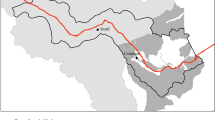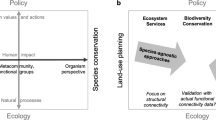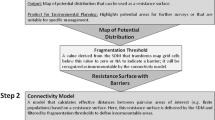Abstract
Context
Conserving or restoring connectivity is a common objective of landscape-scale conservation initiatives. However, precise species occurrence or movement data to inform or validate spatial models are often lacking.
Objectives
Our objectives were to (1) produce the first approximation of country-wide connectivity for Andean bears (Tremarctos ornatus) in Colombia and (2) demonstrate a novel approach for model validation which uses publicly available web and social media records of a flagship species.
Methods
We used general knowledge about Andean bear habitat associations and indices of ecological integrity to construct a resistance surface across the Colombian Andes. We used this resistance surface to model omnidirectional connectivity using circuit theory. We validated our model with coarse location data acquired from local news stories and social media posts.
Results
Our model was most sensitive to changes in the resistance values of agricultural landcover and the mid-elevational zone, but uncertainty analysis demonstrated these changes had little impact on our conclusions regarding the municipalities most conducive to Andean bear movement. Just over one-third of those areas most conducive to Andean bear movement were within protected areas, while 8% coincided with agricultural landcover.
Conclusions
We constructed a model of connectivity that did not rely on independent, empirically derived location data. Our model is coarse (1 km resolution) but can still provide useful information to practitioners in Colombia who are working with scarce ecological data. More information about how Andean bears move through agricultural landscapes would help improve our understanding of connectivity for this species in Colombia.






Similar content being viewed by others
Data availability
Data available upon request.
Code availability
Code available upon request.
References
Adriaensen F, Chardon J, De Blust G, Swinnen E, Villalba S, Gulinck H, Matthysen E (2003) The application of ‘least-cost’ modelling as a functional landscape model. Landsc Urban Plan 64:233–247
Anantharaman R, Hall K, Shah V, Edelman A (2019) Circuitscape in Julia: High performance connectivity modelling to support conservation decisions. Available at arXiv:190603542
Armenteras D, Gast F, Villareal H (2003) Andean forest fragmentation and the representativeness of protected natural areas in the eastern Andes, Colombia. Biol Cons 113:245–256
Balestrieri A, Mori E, Menchetti M, Ruiz-González A, Milanesi P (2019) Far from the madding crowd: tolerance toward human disturbance shapes distribution and connectivity patterns of closely related Martes spp. Popul Ecol 61:289–299
Beier P, Majka DR, Spencer WD (2008) Forks in the road: choices in procedures for designing wildland linkages. Conserv Biol 22:836–851
Beier P, Spencer W, Baldwin RF, McRae BH (2011) Toward best practices for developing regional connectivity maps. Conserv Biol 25:879–892
Blackman A, Hoffman S, Morgenstern R, Topping E (2004) Assessment of Colombia’s National Environmental System (SINA). Resources for the Future, Washington, D.C.
Blair ME, Melnick DJ (2012) Scale-dependent effects of a heterogeneous landscape on genetic differentiation in the Central American squirrel monkey (Saimiri oerstedii). PLoS ONE 7:e43027
Bowman J, Adey E, Angoh SYJ, Baici JE, Brown MGC, Cordes C, Dupuis AE, Newar SL, Scott LM, Solmundson K (2020) Effects of cost surface uncertainty on current density estimates from circuit theory. PeerJ 8:e9617
Brown ED, Williams BK (2019) The potential for citizen science to produce reliable and useful information in ecology. Conserv Biol 33:561–569
Buytaert W, Cuesta-Camacho F, Tobón C (2011) Potential impacts of climate change on the environmental services of humid tropical alpine regions. Glob Ecol Biogeogr 20:19–33
Cáceres-Martínez CH, Montano LRS, Acevedo AA, González-Maya JF (2020) Diet of Andean bears in Tamá National Natural Park, Colombia. Ursus 2020:1–11
Cosse M, Sachetti JFDM, Mannise N, Acosta M (2014) Genetic evidence confirms presence of Andean bears in Argentina. Ursus 25:163–172
Cushman SA, McRae B, Adriaensen F, Beier P, Shirley M, Zeller K (2013) Biological corridors and connectivity. In: Macdonald DW, Willis KJ (eds) Key topics in conservation biology. Wiley, West Sussex, pp 384–404
Devictor V, Whittaker RJ, Beltrame C (2010) Beyond scarcity: Citizen science programmes as useful tools for conservation biogeography. Divers Distrib 16:354–362
Devitt TJ, Devitt SEC, Hollingsworth BD, McGuire JA, Moritz C (2013) Montane refugia predict population genetic structure in the large-blotched Ensatina salamander. Mol Ecol 22:1650–1665
Dickson BG, Albano CM, Anantharaman R, Beier P, Fargione J, Graves TA, Gray ME, Hall KR, Lawler JJ, Leonard PB (2019) Circuit-theory applications to connectivity science and conservation. Conserv Biol 33:239–249
Earth Resources Observation Science [EROS] (1996) 30 arc-second DEM of South America. U.S. Geological Survey, Reston
Escobar-Lasso S, Cepeda-Duque JC, Gil-Fernández M, González-Maya JF (2020) Is the banana ripe? Andean bear–human conflict in a protected area of Colombia. Hum-Wildl Interact 14:10
Etter A, McAlpine C, Possingham H (2008) Historical patterns and drivers of landscape change in Colombia since 1500: a regionalized spatial approach. Ann Assoc Am Geogr 98:2–23
Evans J (2020) spatialEco: R package for spatial analysis and modeling of ecological systems. R package version 1.3-1
Falconi N, Fuller TK, DeStefano S, Organ JF (2020) An open-access occurrence database for Andean bears in Peru. Ursus 2020:1–6
Figueroa J (2015) Interacciones humano-oso andino Tremarctos ornatus en el Perú: Consumo de cultivos y depredación de ganado [Human-Andean bear Tremarctos ornatus interaction in Peru: Consumption of crops and depredation of livestock]. Therya 6:251–278
García-Rangel S (2012) Andean bear Tremarctos ornatus natural history and conservation. Mammal Rev 42:85–119
Global Biodiversity Information Facility [GBIF] (2021) Filtered export of GBIF occurrence data. https://doi.org/10.15468/dd.hfq3kg
Goldstein I, Paisley S, Wallace R, Jorgenson JP, Cuesta F, Castellanos A (2006) Andean bear–livestock conflicts: a review. Ursus 17:8–15
Hohbein R (2021) Ecological and institutional landscapes of Andean bear conservation in Colombia. Dissertation, University of Georgia
Instituto de Hidrología, Meterología y Estudios Ambientales [IDEAM] (2014) Mapa de coberturas de la tierra periodo (2010–2012) [Map of the Landcover during 2010–2012]. Ministerio de Ambiente y Desarrollo Sostenible de Colombia, Bogotá
International Union for Conservation of Nature [IUCN] (2017) Tremarctos ornatus. The IUCN Red List of Threatened Species. Version 2017-3. https://www.iucnredlist.org/. Accessed on 10 July 2019
International Union for Conservation of Nature [IUCN] (2020) Connectivity Conservation. https://www.iucn.org/commissions/world-commission-protected-areas/our-work/connectivity-conservation. Accessed on 25 Aug 2020
Jackson CR, Marnewick K, Lindsey PA, Røskaft E, Robertson MP (2016) Evaluating habitat connectivity methodologies: a case study with endangered African wild dogs in South Africa. Landsc Ecol 31:1433–1447
Jenks GF (1967) The data model concept in statistical mapping. Int Yearb Cartogr 7:186–190
Jorgenson JP, Sandoval-A S (2005) Andean bear management needs and interactions with humans in Colombia. Ursus 16:108–116
Kattan G, Hernández OL, Goldstein I, Rojas V, Murillo O, Gómez C, Restrepo H, Cuesto F (2004) Range fragmentation in the spectacled bear Tremarctos ornatus in the northern Andes. Oryz 38:155–163
Kleiner JD, Van Horn RC, Swenson JE, Steyaert SM (2018) Rub-tree selection by Andean bears in the Peruvian dry forest. Ursus 29:58–66
Kobori H, Dickinson JL, Washitani I, Sakurai R, Amano T, Komatsu N, Kitamura W, Takagawa S, Koyama K, Ogawara T (2016) Citizen science: a new approach to advance ecology, education, and conservation. Ecol Res 31:1–19
Koen EL, Garroway CJ, Wilson PJ, Bowman J (2010) The effect of map boundary on estimates of landscape resistance to animal movement. PLoS ONE 5:e11785
Koen EL, Bowman J, Sadowski C, Walpole AA (2014) Landscape connectivity for wildlife: development and validation of multispecies linkage maps. Methods Ecol Evol 5:626–633
Koen EL, Ellington EH, Bowman J (2019) Mapping landscape connectivity for large spatial extents. Landsc Ecol 34:2421–2433
Krosby M, Breckheimer I, Pierce DJ, Singleton PH, Hall SA, Halupka KC, Gaines WL, Long RA, McRae BH, Cosentino BL (2015) Focal species and landscape “naturalness” corridor models offer complementary approaches for connectivity conservation planning. Landsc Ecol 30:2121–2132
Laliberté J, St-Laurent M-H (2020) Validation of functional connectivity modeling: the Achilles’ heel of landscape connectivity mapping. Landsc Urban Plan 202:103878
Llambí LD, Becerra MT, Peralvo M, Avella A, Baruffol M, Flores LJ (2019) Monitoring biodiversity and ecosystem services in Colombia’s high Andean ecosystems: toward an integrated strategy. Mt Res Dev 39:A8
Mayr Maldonado J (2001) Programa Nacional Para la Conservación en Colombia del Oso Andino-Tremarctos ornatus [National program for the conservation of the Andean bear-Tremarctos ornatus-in Colombia]. Ministerio del Medio Ambiente, Bogotá
McClure ML, Hansen AJ, Inman RM (2016) Connecting models to movements: testing connectivity model predictions against empirical migration and dispersal data. Landsc Ecol 31:1419–1432
McRae BH, Dickson BG, Keitt TH, Shah VB (2008) Using circuit theory to model connectivity in ecology, evolution, and conservation. Ecology 89:2712–2724
McRae B, Shah V, Mohapatra T (2013) Circuitscape 4 user guide. The Nature Conservancy, Seattle
Mittermeier RA, Myers N, Mittermeier CG, Robles Gil P (1999) Hotspots: Earth’s biologically richest and most endangered terrestrial ecoregions. CEMEX, SA, Agrupación Sierra Madre, SC
Instituto Nacional de Vías [INVIAS] (2019) Red vial nacional de carreteras [National network of highways]. Ministerio de Transporte
Newbold T (2010) Applications and limitations of museum data for conservation and ecology, with particular attention to species distribution models. Prog Phys Geogr 34:3–22
Parques Nacionales Naturales de Colombia (2018) Mapa de áreas protegidas de Colombia [Map of protected areas in Colombia] El Registro Único Nacional de Áreas Protegidas. https://runap.parquesnacionales.gov.co/cifras
Parra-Romero Á (2011) Análisis integral del conflicto asociado a la presencia del oso andino (Tremarctos ornatus) y el desarrollo de sistemas productivos ganaderos en áreas de amortiguación del PNN Chingaza [Integrated analysis of the conflict associated with the presence of the Andean bear (Tremarctos ornatus) and the development of ranching systems in the buffer zone of PNN Chingaza]. Thesis, Pontifica Universidad Javeriana
Parra-Romero Á, Galindo-Tarazona R, González-Maya JF, Vela-Vargas IM (2019) Not eating alone: Andean bear time patterns and potential social scavenging behaviors. Therya 10:49–53
Pelletier D, Clark M, Anderson MG, Rayfield B, Wulder MA, Cardille JA (2014) Applying circuit theory for corridor expansion and management at regional scales: tiling, pinch points, and omnidirectional connectivity. PLoS ONE 9:e84135
Peyton B (1980) Ecology, distribution, and food habits of spectacled bears, Tremarctos ornatus, in Peru. J Mammal 61:639–652
Peyton B (1987) Habitat components of the spectacled bear in Machu Picchu, Peru. Bears: their biology and management. pp 127–133
Peyton B (1999) Spectacled bear conservation action plan. In: Bears: status survey and conservation action plan. pp 157–198
Ríos-Uzeda B, Gómez H, Wallace R (2006) Habitat preferences of the Andean bear (Tremarctos ornatus) in the Bolivian Andes. J Zool 268:271–278
Rodríguez D, Reyes A, Reyes-Amaya N, Gallegos-Sánchez S, Gutiérrez J, Suárez R, Prieto F (2019) Northernmost distribution of the Andean bear (Tremarctos ornatus) in South America, and fragmentation of its associated Andean forest and Paramo ecosystems. Therya 10:161–170
Rodríguez-Castro D, Contento S, Grajales D, Reyes S, Reyes Amaya NR, Rodríguez C (2015) Evaluación del estado de aplicación del Programa Nacional para la Conservación en Colombia del Oso Andino (Tremarctos ornatus) [Evaluation of the state of implementation of the National Program for the Conservation of the Andean bear in Colombia]. Rev Biodivers Neotrop 5:36–46
Ruiz-García M (2003) Molecular population genetic analysis of the spectacled bear (Tremarctos ornatus) in the Northern Andean Area. Hereditas 138:81–93
Ruiz-García M, Arias Vásques JY, Restrepo H, Cáceres-Martínez CH, Shostell JM (2020) The genetic structure of the spectacled bear (Tremarctos ornatus; Ursidae, Carnivora) in Colombia by means of mitochondrial and microsatellite markers. J Mammal 101:1072–1090
St-Louis V, Forester JD, Pelletier D, Bélisle M, Desrochers A, Rayfield B, Wulder MA, Cardille JA (2014) Circuit theory emphasizes the importance of edge-crossing decisions in dispersal-scale movements of a forest passerine. Landsc Ecol 29:831–841
Theobald EJ, Ettinger AK, Burgess HK, DeBey LB, Schmidt NR, Froehlich HE, Wagner C, HilleRisLambers J, Tewksbury J, Harsch MA (2015) Global change and local solutions: Tapping the unrealized potential of citizen science for biodiversity research. Biol Cons 181:236–244
Urrutia R, Vuille M (2009) Climate change projections for the tropical Andes using a regional climate model: temperature and precipitation simulations for the end of the 21st century. J Geophys Res Atmos 114:12. https://doi.org/10.1029/2008JD011021
Velásquez Durán AM (2018) Resultados de las estrategias de conservación del oso andino en Colombia y efectividad de las tecnologías de monitoreo [Results of Andean bear conservation strategies in Colombia and effectiveness of monitoring technologies]. Thesis, Universidad Jorge Tadeo Lozano
Velez-Liendo X, García-Rangel S (2017) Tremarctos ornatus. The IUCN red list of threatened species. Available at http://www.iucnredlist.org/details/22066/0
Walpole AA, Bowman J, Murray DL, Wilson PJ (2012) Functional connectivity of lynx at their southern range periphery in Ontario, Canada. Landsc Ecol 27:761–773
Walther G-R, Post E, Convey P, Menzel A, Parmesan C, Beebee TJC, Fromentin J-M, Hoegh-Guldberg O, Bairlein F (2002) Ecological responses to recent climate change. Nature 416:389–395
Yerena E (1998) Protected areas for the Andean bear in South America. Ursus 10:101–106
Zeller KA, Wattles DW, Destefano S (2020) Evaluating methods for identifying large mammal road crossing locations: black bears as a case study. Landsc Ecol 35:1799–1808
Acknowledgements
We thank E. Koen and 2 anonymous reviewers for their valuable feedback on an earlier version of this manuscript.
Funding
The research was supported by the Warnell School of Forestry and Natural Resources and the Graduate School at the University of Georgia.
Author information
Authors and Affiliations
Contributions
RH and NN designed the study. RH conducted the analysis and wrote the manuscript. NN provided guidance in the development and implementation of the research and reviewed/edited the manuscript.
Corresponding author
Ethics declarations
Conflict of interest
The authors have no relevant financial or non-financial interests to disclose.
Consent for publication
Both authors are aware of this submission and consent to this manuscript being published in Landscape Ecology.
Additional information
Publisher's Note
Springer Nature remains neutral with regard to jurisdictional claims in published maps and institutional affiliations.
Supplementary Information
Below is the link to the electronic supplementary material.
10980_2021_1299_MOESM1_ESM.xlsx
Online Resource 1 Categorical assignments of the 53 landcover classes originally identified in the landcover dataset from Colombia’s Institute of Hydrology, Meteorology, and Environmental Studies (IDEAM 2014). Supplementary file1 (XLSX 10 KB)
10980_2021_1299_MOESM2_ESM.xlsx
Online Resource 2 Citations of the 110 records within which we found references of Andean bear sightings or locations. Supplementary file2 (XLSX 21 KB)
10980_2021_1299_MOESM3_ESM.xlsx
Online Resource 3 Eight percent of the habitat considered most conducive to Andean bear movement in Colombia coincided with agricultural landcover. These are the 15 municipalities where this overlap occurred most frequently and thus where conflict mitigation strategies might be most urgently needed. Supplementary file3 (XLSX 9 KB)
Rights and permissions
About this article
Cite this article
Hohbein, R.R., Nibbelink, N.P. Omnidirectional connectivity for the Andean bear (Tremarctos ornatus) across the Colombian Andes. Landscape Ecol 36, 3169–3185 (2021). https://doi.org/10.1007/s10980-021-01299-3
Received:
Accepted:
Published:
Issue Date:
DOI: https://doi.org/10.1007/s10980-021-01299-3




